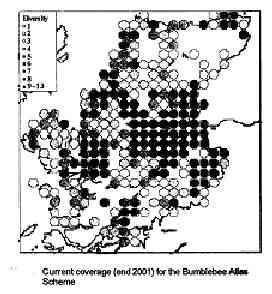|
Current Biological Recording Schemes
(by Ken Butler)
These are schemes being run in the
current year by various organisations to enhance knowledge of our natural
habitat. Members are encouraged to contribute if they can. Some schemes
require a degree of knowledge and dedication, while others require only
common knowledge and the will to write it down. The standing schemes which
run in the long term were described in the last issue of the Bulletin (ref
1). This articles denotes special schemes being given emphasis currently.
Galls on Scots Pine
One of the schemes of the Highland Biological Recording Group for 2003 is
to record galls seen on Scots Pine trees. This is not a big issue in
Caithness since there are no natural pinewoods and few individual pine
trees. Nevertheless where trees are seen please examine them for galls and
report anything to Phillip F Entwistle (phone 01862 881327). There is a
witches broom type of gall which results in a twiggy sphere at the end of
a branch; there are two types of gall that result in small spherical
bulges on twigs and there is a fourth type of gall that results in local
thickening of a twig with little orange ears. More details can be obtained
from reference 2.
Beach Combing
Here is a recording scheme (see ref 2 again) that requires no special
skill. Simply take walks on local beaches and, if you find any of the
following, keep a record and a specimen.They are all chosen to be readily
identified from a popular handbook of the seashore such as reference 3.
� The sea gooseberry Pleurobrachia
pileus
� Egg masses of necklace shells, either the Large Necklace shell,
Polinices catenata or the Common.
Necklace Polinices polianus. In your seashore book the family name may be
given as Polinices, Euspira
or Natica.
� Common whelk egg masses, Buccinium undatum
� The sea mouse Aphrodita aculeata
� Egg wrack Ascophyllum nodosum
Observations should be sent to Inverness
Museum or to David W McAllister 01862 892302
zawalke@aol.com
Mammals
There is an ongoing project to record mammals. At present there is
emphasis on recording small things - rats, bats, mice, voles, shrews. Also
sightings of Sika deer and Muntjac deer are of great interest. The contact
is Ro Scott 01381 600392,
ro.scott@care4free.net
Bumblebees
There is a national scheme for recording bumblebees. It requires some
training and skill, but most people become competent during one season of
trying. The map on the next page shows that Caithness and adjacent parts
of Sutherland are not well recorded. Some volunteers to learn about
bumblebees and record them are urgently needed. The contact is Dr Murdo
Macdonald 01997 421797,
Murdo.Macdonald@
hcs.uhi.ac.uk

References
1. Biological Recording in Caithness by Ken Butler, Caithness Field Club
Bulletin 6,6, April 2002.
2. Newsletter No 15, July 2002, Highland Biological Recording Group
3. Hayward, Nelson-Smith and Shields (1996) Collins Pocket Guide to the
Seashore of Britain and Europe.
Harper Collins, Lond. |











